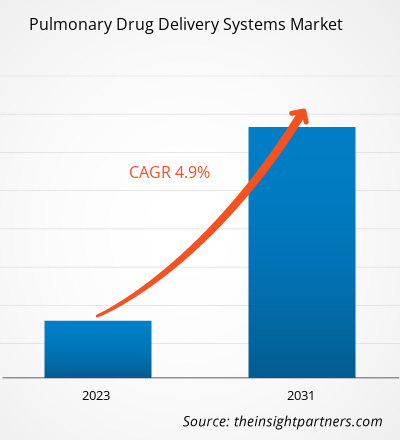预计到 2031 年,肺部给药系统市场规模将从 2024 年的 541.4 亿美元增至 731.4 亿美元;预计该市场在 2025 年至 2031 年期间的复合年增长率为 4.4%。
市场洞察和分析师观点:
肺部给药系统用于通过吸入将气溶胶直接输送至上皮细胞和呼吸道上皮。该系统包括吸入器和雾化器等装置,用于将药物输送至肺部,治疗患有呼吸系统疾病的患者。肺部给药装置基于多种输送机制,并包含各种药物剂型。哮喘、慢性阻塞性肺病 (COPD)、急性呼吸道感染、过敏性鼻炎和囊性纤维化是需要使用给药装置治疗的主要呼吸系统疾病。呼吸系统疾病负担的加重以及企业不断推出的战略举措,都有利于肺部给药系统市场的增长。肺部给药系统市场趋势包括吸入器技术的进步,这将有利于未来市场的增长。
增长动力:
肺部给药系统市场的公司持续关注战略发展,例如合作、协议、伙伴关系和新产品发布。这些战略有助于他们提高销售额、扩大地域覆盖范围,并增强服务现有客户群的能力。新产品的发布主要旨在提高安全性、提供用户友好型功能、改进给药方案等,以吸引更多患者。以下是肺部药物输送系统市场的一些值得注意的发展:
- 2021 年 9 月,BreatheSuite Inc. 获得了美国食品药品监督管理局 (FDA) 的 510(K) 许可,其 BreatheSuite 定量吸入器 V1 设备可用于处方和非处方使用。 BreatheSuite V1 通过自动精准监测哮喘和慢性阻塞性肺病 (COPD) 患者的吸入依从性和使用技巧,并提供反馈,将现有的定量吸入器改造成智能吸入器。
- 2021 年 6 月,Glenmark Pharmaceuticals Ltd 在英国推出了 Tiogiva,这是噻托溴铵干粉吸入器的生物等效版本,用于治疗 COPD。
- 2021 年 4 月,KINDEVA DRUG DELIVERY 与剑桥医疗创新有限公司 (CHI) 合作,开发并商业化 CHI 的 αeolus 干粉吸入器 (DPI) 平台技术。
- 2020 年 12 月,创新数字健康公司 AireHealth 的联网雾化器获得了 510(k) 许可。该设备是一款便携式电子振动网状雾化器。它旨在将液体药物雾化供患者吸入。它以 VitalMed 品牌销售。
- 2020 年 9 月,葛兰素史克公司和 Innoviva, Inc. 获得 FDA 批准,将 Trelegy Ellipta 作为美国首个每日一次的单吸入器三联疗法,用于治疗美国 18 岁及以上的哮喘和 COPD 患者。
因此,公司为保持市场竞争力而不断推出的战略发展和产品推动了肺部药物输送系统市场的增长。
自定义此报告以满足您的要求
您将免费获得任何报告的定制,包括本报告的部分内容,或国家级分析、Excel 数据包,以及为初创企业和大学提供超值优惠和折扣
肺部给药系统市场: 战略洞察

- 获取本报告的主要市场趋势。这个免费样本将包括数据分析,从市场趋势到估计和预测。
您将免费获得任何报告的定制,包括本报告的部分内容,或国家级分析、Excel 数据包,以及为初创企业和大学提供超值优惠和折扣
肺部给药系统市场: 战略洞察

- 获取本报告的主要市场趋势。这个免费样本将包括数据分析,从市场趋势到估计和预测。
报告细分和范围:
肺部给药系统市场分析考虑了以下几个部分:产品、适应症、分销渠道、最终用户和地域。就产品而言,市场细分为干粉吸入器、雾化器和定量吸入器。根据适应症,市场分为慢性阻塞性肺病、哮喘、囊性纤维化等。根据分销渠道,市场分为医院药房、零售药房和电子商务。根据最终用户,市场分为医院和诊所以及家庭护理。肺部给药系统市场报告的范围涵盖北美(美国、加拿大和墨西哥)、欧洲(法国、德国、英国、西班牙、意大利和欧洲其他地区)、亚太地区(中国、日本、印度、韩国、澳大利亚和亚太其他地区)、中东和非洲(沙特阿拉伯、南非、阿联酋以及中东和非洲其他地区)和南美洲和中美洲(巴西、阿根廷以及南美洲和中美洲其他地区)。
分段分析:
按产品划分,肺部给药系统市场分为干粉吸入器、雾化器和定量吸入器。干粉吸入器细分市场在 2023 年占据了相当大的市场份额。预计在 2023 年至 2031 年期间,其复合年增长率将达到最高。
按适应症划分,肺部给药系统市场分为慢性阻塞性肺病、哮喘、囊性纤维化等。慢性阻塞性肺疾病领域在2023年占据了相当大的市场份额,预计在2023年至2031年期间将实现最高的复合年增长率。
根据分销渠道,市场细分为医院药房、零售药房和电子商务。2023年,医院药房领域在肺部给药系统市场中占据了相当大的份额。预计在2023年至2031年期间,电子商务领域将实现最高的复合年增长率。
根据最终用户,肺部给药系统市场分为医院和诊所以及家庭护理。医院和诊所诊所细分市场在 2023 年占据了相当大的市场份额。预计家庭护理细分市场在 2023 年至 2031 年期间的复合年增长率将更高。
区域分析:
从地理上看,肺部给药系统市场分为北美、欧洲、亚太地区、南美和中美以及中东和非洲。2023 年,北美占据了相当大的市场份额。2023 年,美国占据了该地区最大的市场份额。北美市场的增长归因于哮喘、慢性阻塞性肺病等呼吸系统疾病发病率的上升;老年人口的增加;对诊断设备的需求不断增长;以及主要市场参与者的强大影响力。根据美国疾病控制与预防中心 (CDC) 的数据,2020 年,美国约有 5.0% 的成年人被诊断患有慢性阻塞性肺病或慢性支气管炎。约有2500万人患有哮喘,1480万人患有慢性阻塞性肺病(COPD)。此外,加拿大护士协会估计,加拿大约有300万人患有慢性阻塞性肺病、囊性纤维化、哮喘和职业性肺病等严重呼吸系统疾病。
据加拿大肺脏协会统计,呼吸系统疾病是住院人数第三多的疾病,约五分之一的加拿大人患有严重的呼吸系统疾病,例如哮喘、慢性阻塞性肺病、肺癌、肺结核、囊性纤维化和呼吸窘迫综合征。患有各种呼吸系统疾病的患者数量不断增加,推动了对创新有效的肺部给药系统(例如定量吸入器或雾化器)的需求。
肺部药物输送系统市场区域洞察
The Insight Partners 的分析师已详尽阐述了预测期内影响肺部给药系统市场的区域趋势和因素。本节还讨论了北美、欧洲、亚太地区、中东和非洲以及南美和中美洲的肺部给药系统市场细分和地域分布。
肺部药物输送系统市场报告范围
肺部给药系统市场参与者密度:了解其对业务动态的影响
肺部给药系统市场正在快速增长,这得益于终端用户需求的不断增长,而这些需求的驱动因素包括消费者偏好的演变、技术进步以及对产品优势的认知度的提升。随着需求的增长,企业正在扩展产品线,不断创新以满足消费者需求,并抓住新兴趋势,从而进一步推动市场增长。

- 获取 肺部给药系统市场 主要参与者概述
行业发展与未来机遇:
肺部给药系统市场报告涵盖公司定位和集中度,以评估市场竞争对手的表现。根据公司新闻稿,以下是市场主要参与者采取的一些举措:
- 2021年3月,PARI Pharma GmbH 获得 LAMIRA 雾化器系统的授权,用于在日本输送 Insmed 的药品 ARIKAYCE(阿米卡星脂质体吸入混悬液)。Insmed 于2021年3月获得日本厚生劳动省对 ARIKAYCE 的批准。此前,ARIKAYCE 已在美国和欧洲获得批准,此次在日本获得批准。
- 2020年12月,欧盟委员会批准阿斯利康的 Trixeo Aerosphere 在欧盟用于治疗慢性阻塞性肺病 (COPD)。它用于治疗患有中度至重度慢性阻塞性肺病 (COPD) 的成年患者。Trixeo Aerosphere 是一种单吸入器,由富马酸福莫特罗、格隆溴铵、布地奈德和吸入性皮质类固醇组成,采用固定剂量三联疗法,通过加压定量吸入器输送。
竞争格局和主要公司:
肺部给药系统市场预测可以帮助利益相关者规划其增长战略。阿斯利康、葛兰素史克、诺华、荷兰皇家飞利浦、勃林格殷格翰国际有限公司、西普拉公司、欧姆龙公司、PARI GmbH、Glenmark Pharmaceuticals 和 Gilbert Technologies 是该市场的领军企业。这些公司专注于推出新的高科技产品、改进现有产品并拓展地域范围,以满足全球日益增长的消费者需求。
- 历史分析(2 年)、基准年、预测(7 年)及复合年增长率
- PEST和SWOT分析
- 市场规模、价值/数量 - 全球、区域、国家
- 行业和竞争格局
- Excel 数据集
近期报告
相关报告
客户评价
购买理由
- 明智的决策
- 了解市场动态
- 竞争分析
- 客户洞察
- 市场预测
- 风险规避
- 战略规划
- 投资论证
- 识别新兴市场
- 优化营销策略
- 提升运营效率
- 顺应监管趋势




















 获取免费样品 - 肺部给药系统市场
获取免费样品 - 肺部给药系统市场